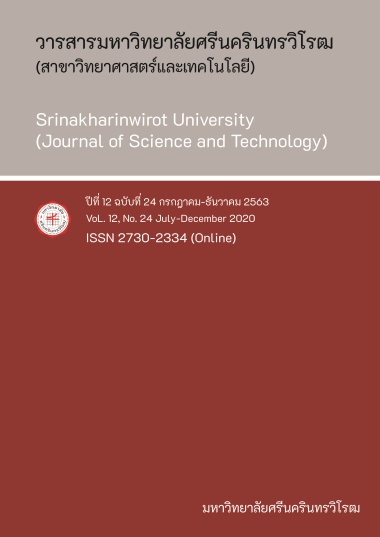ขั้นตอนวิธีสำหรับการสร้างสมมติฐานการวิจัยแบบมีทิศทาง โดยใช้เทคนิคการค้นหาเส้นทางในแนวลึก AN ALGORITHM FOR GENERATING DIRECTIONAL RESEARCH HYPOTHESIS USING DEPTH-FIRST SEARCH TECHNIQUE
Keywords:
การค้นหาเส้นทางในแนวลึก, System thinking, Depth-first searchAbstract
The objectives of this research were to develop an algorithm for generating directional research hypothesis using depth-first search technique, named as GHyp which was developed by JavaScript language. This research consisted of five processes that were 1) studied and reviewed the concept of system thinking and related works 2) collected and analyzed information 3) analyzed and designed GHyp 4) developed and tested GHyp, and 5) evaluated the quality of the proposed algorithm. The results of this research found that the GHyp algorithm could correctly generate of all directional research hypothesis according to the expected results. Moreover, the quality of GHyp algorithm assessed by experts found that the Index of the item-objective congruence of expert opinion analysis on every GHyp algorithms was equal to 0.97. Conclusively, GHyp could be practical and could be used as the tool for generating directional research hypothesis, including used as the obvious conceptual research framework. As a result, users had more systematic thinking skills and more hypothesis-building skills.
Downloads
References
[2] Pattarasinee Bhattarakosol. (2018). Let Tell the Story: Research with Heart. 1st ed. Bangkok: Chulalongkorn University Press.
[3] Tanawat Chamnansing. (2010). Hypothesis of Research. Retrieved August 31, 2016, from https://www.gotoknow.org/posts/413956
[4] Piyanat Prayoon. (2005). Systems Thinking. 2nd ed. Bangkok: Learning and Empowerment for Healthy Community Project (LEHC).
[5] Suteera Prasertsan. (2012). Research – Based Project: New Learning Process of Thai Education. 1st ed. Bangkok: The Thailand Research Fund (TRF).
[6] Thawin Arunwet. (2017). System Thinking. Retrieved December 4, 2017, from http://thawin09.blogspot.com/2017/06/system-thinking.html
[7] Pornphan Pumpu. (2015). Systems Thinking. Retrieved December 4, 2017, from http://kmcenter.rid.go.th/kcffd/information/Dr%20Pornpan%20Present/Systems%20Thinking%201.doc
[8] Suteera Prasertsan. (2011). Research, The Power to Change Learning: The Path of Cognitive Domain. Chiangmai: Community-Based Research Institute Foundation.
[9] Wattana Rattanaprom. (2017). Research-Based Learning. 1st ed. Songkhla: Numsin Printing.
[10] Ruetairat Chidmongkol, & Somyot Chidmongkol. (2017, April-June). Systems Thinking: Teaching Experiences for Improving Systems Thinking. Journal of Education Studies, 45(2), 209-224.
[11] Bussakorn Khechornphak; Sompong Srikunlaya, & Jiraporn Chano. (2015, July-December). The Development of Systems Thinking Model for Pre-service Teacher, Rajabhat Maha Sarakham University. Journal of Education Rajabhat Maha Sarakham University, 12(2), 50-67.
[12] Sarawut Patcharachompu; Chairat Pranee, & Siriporn Panawong. (2017, January-June). A Development of Instructional Model to Enhance the System Thinking Ability for High Vocational Certificate Curriculum Students. Journal of Graduate Studies in Northern Rajabhat Universities, 7(12), 117-132.
[13] Wilawan Phothong, & Montree Yamkasikorn. (2015, January-June). Systems Thinking: Operation part. Journal of Research and Curriculum Development, 5(1), 1-14. [14] Rosen, Kenneth H. (2012). Discrete Mathematics and Its Applications. 7th ed. New York: McGraw-Hill.
[15] Suteera Prasertsan. et al. (2014). The impress on the path of Pohpanpunya. Bangkok: Wongsawang Publishing & Printing Co., Ltd.
[16] Suteera Prasertsan. (2018). Writing is Thinking. In The Workshop on The Project Development to be SEEEM and Writing is Thinking. Ubon Ratchathani: Ubon Ratchathani University.
[17] The Thailand Research Fund. (2014). Pohpanpunya Project. Retrieved October 10, 2016, from
http://www.trf.or.th/index.php?option=com_content&view=article&id=6708:2015-07-24-12-52-09&catid=333:2557&Itemid=433
[18] Yaowares Pakdeejit. (2014). Active Learning with 21st Century Learning. Retrieved October 3, 2016, from apr.nsru.ac.th/Act_learn/myfile/27022015155130_article.docx
[19] Supaporn Porntrai, & Jittima Wattarach. (2014, July-December). The Effects of Research-Based Learning on Grade-11 Students’ Desirable Characteristic Changing in Pohpanpunya Project. Journal of Research Unit on Science, Technology and Environment for Learning, 5(2), 176-185.
[20] Boonleang Thumthong, & Boonlord Srijarern. (2010, August). A Synthesis of a Learning Organization Model Encouraging the Systematic Thinking Process of Basic Education Level Learners. KKU Research Journal, 15(8), 778-786.
[21] Suteera Prasertsan. (2018). Pohpanpunya: Knowledge from Reason in Cause-Effect. 1st ed. Bangkok: Aksorn Sampan Press (1987).
[22] Pranee Lumbensa. (2016). Finding the Quality of Measurement and Evaluation Tools. In Academic services Project. Thasap Model.
Downloads
Published
How to Cite
Issue
Section
License
Srinakharinwirot University Journal of Sciences and Technology is licensed Under a Creative Commons Attribution-NonCommercial-NoDerivs 4.0 International (CC-BY-NC-ND 4.0) License, Unless Otherwise Stated. Please Read Journal Policies Page for More Information on Open Access, Copyright and Permissions.



